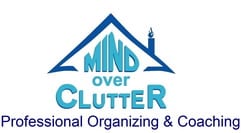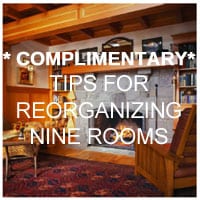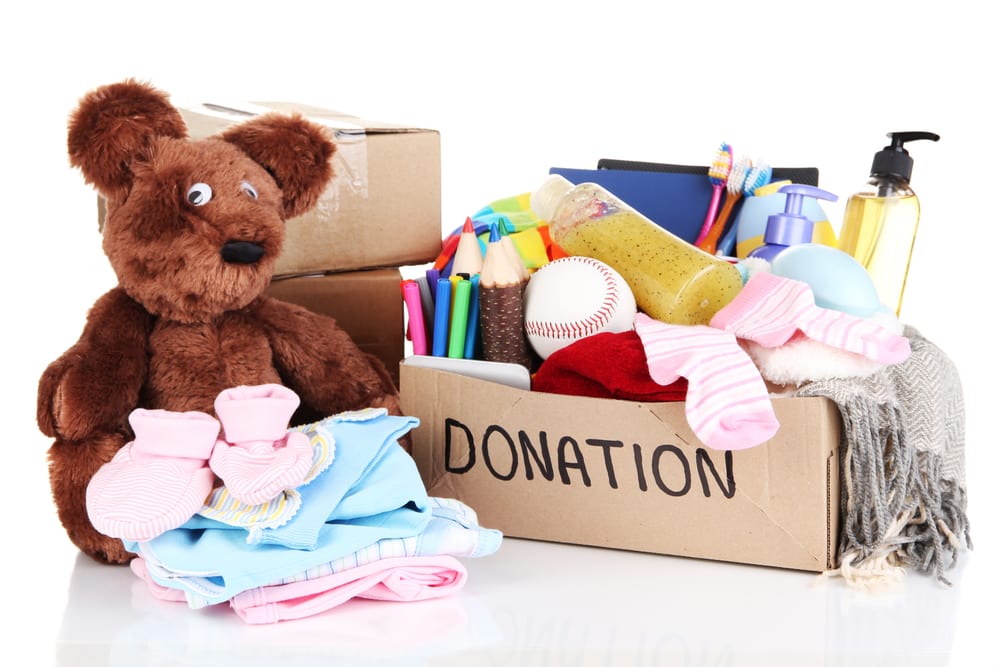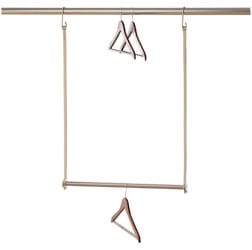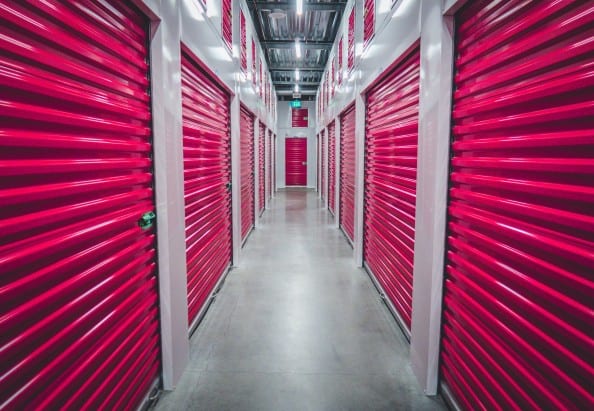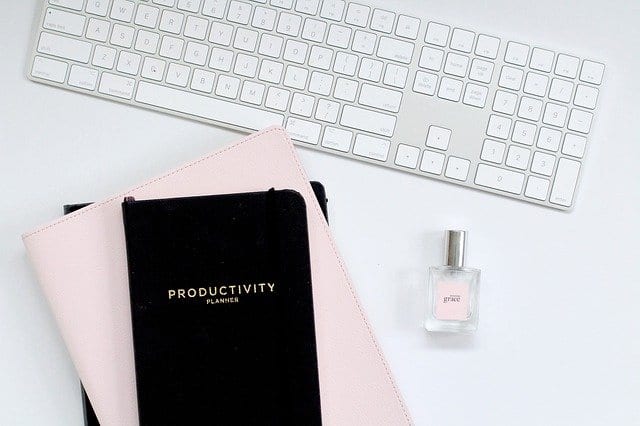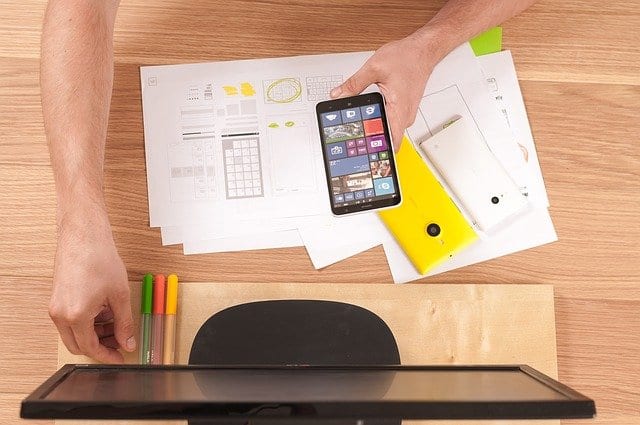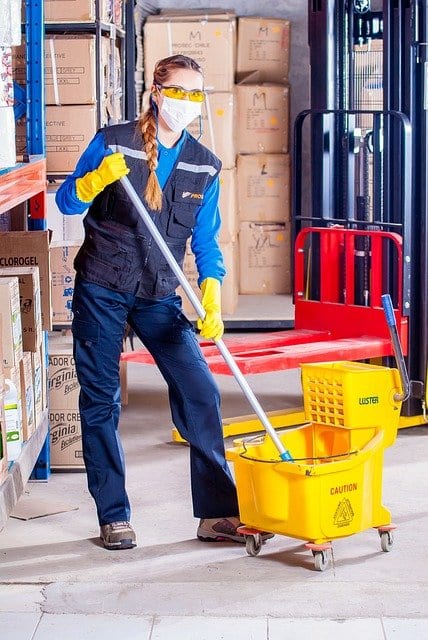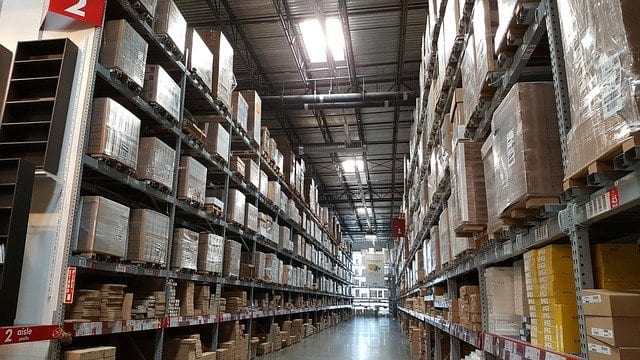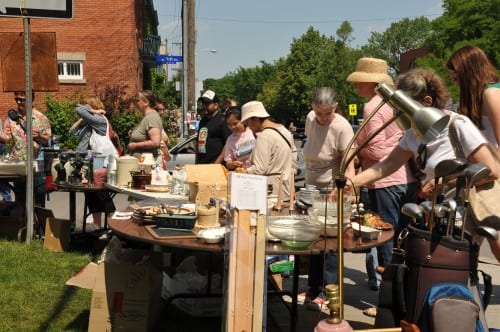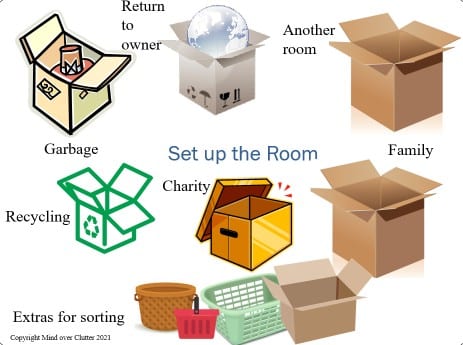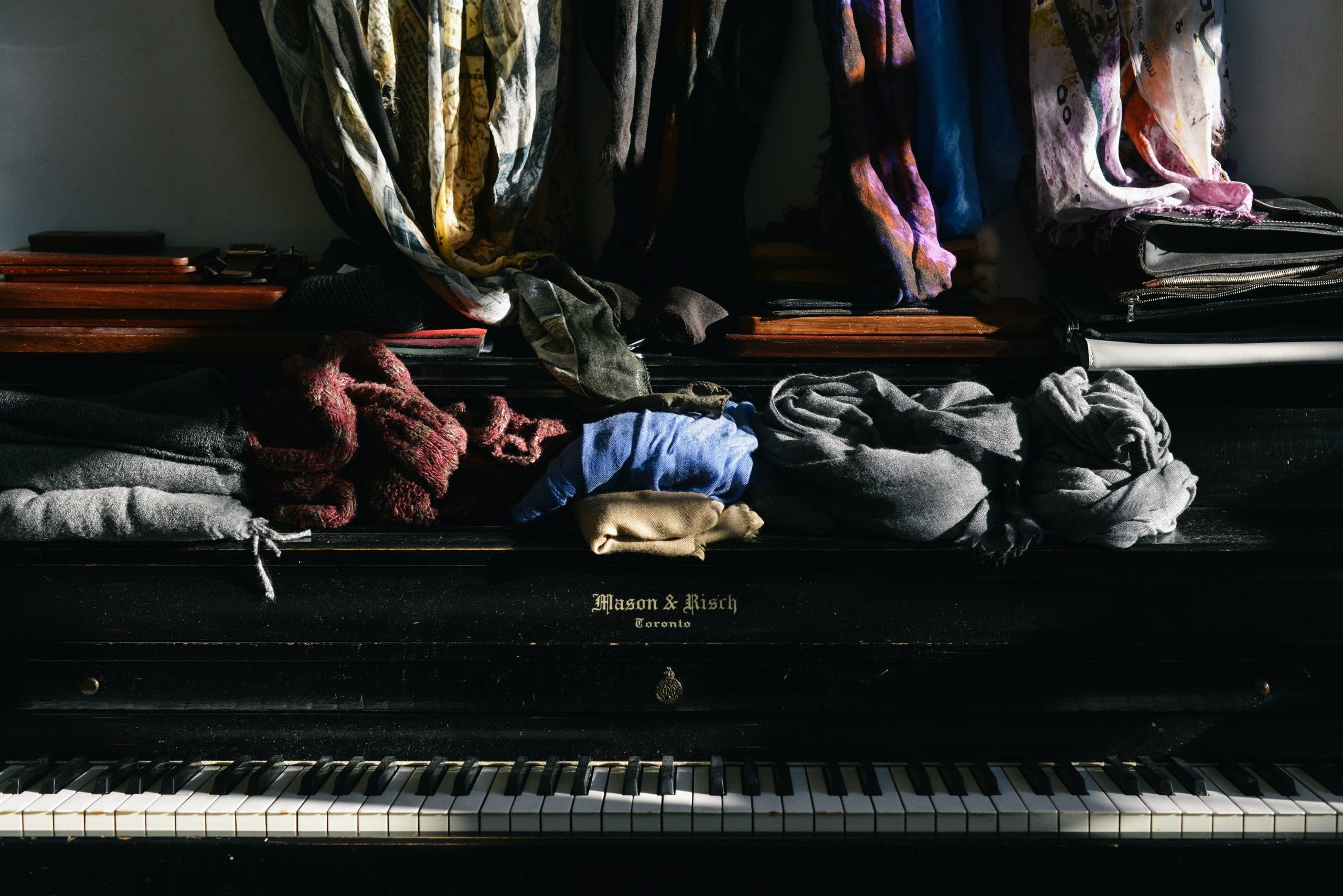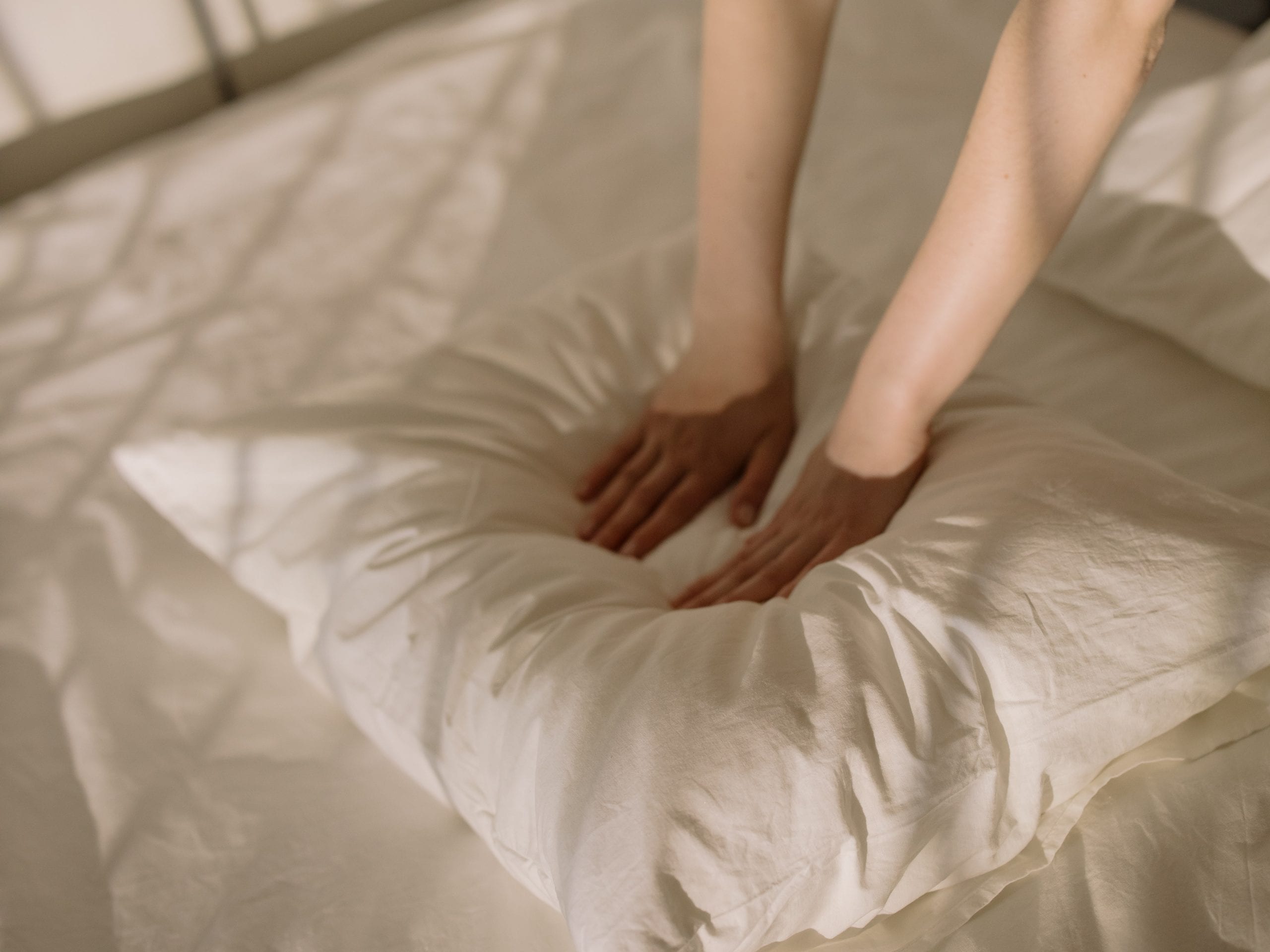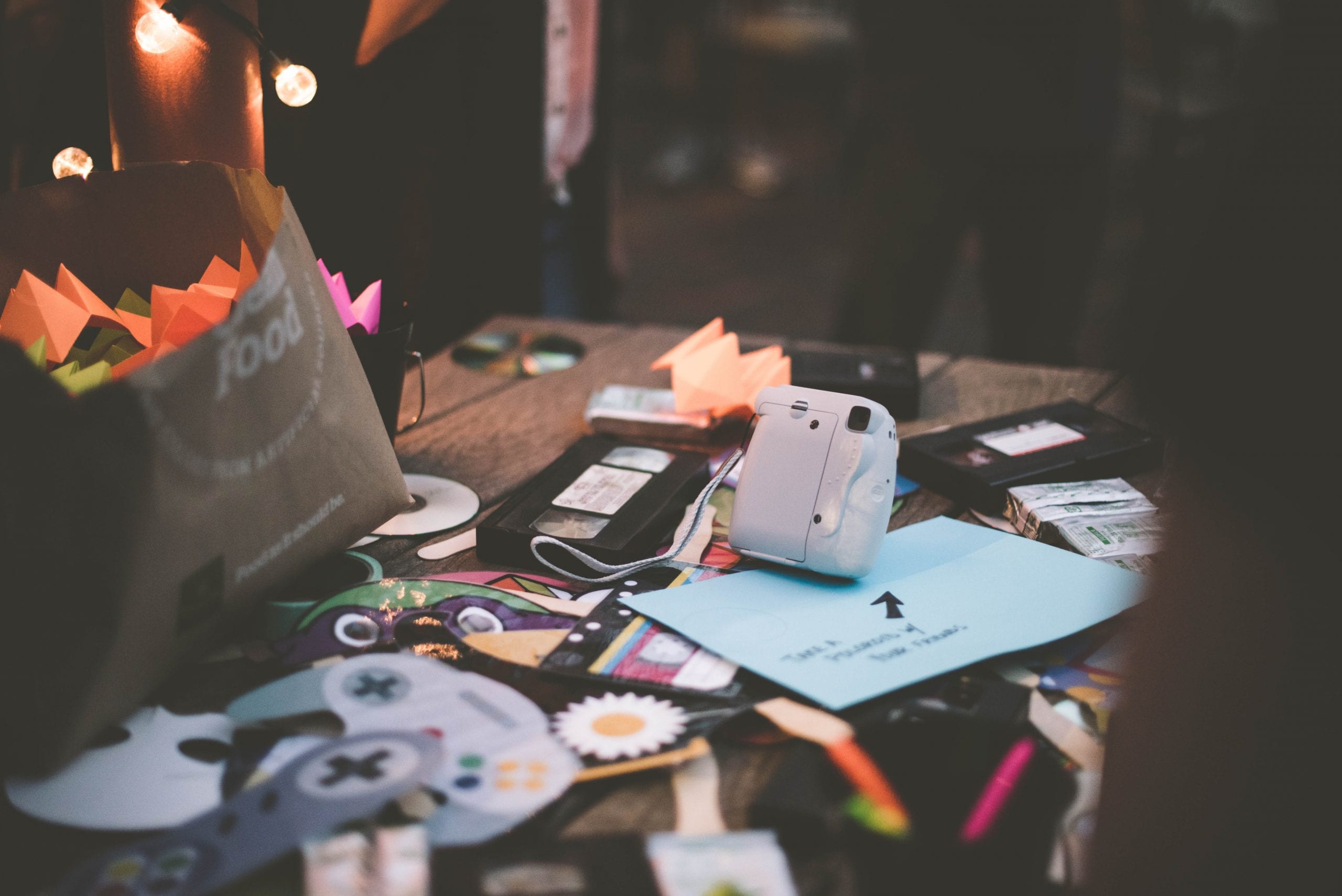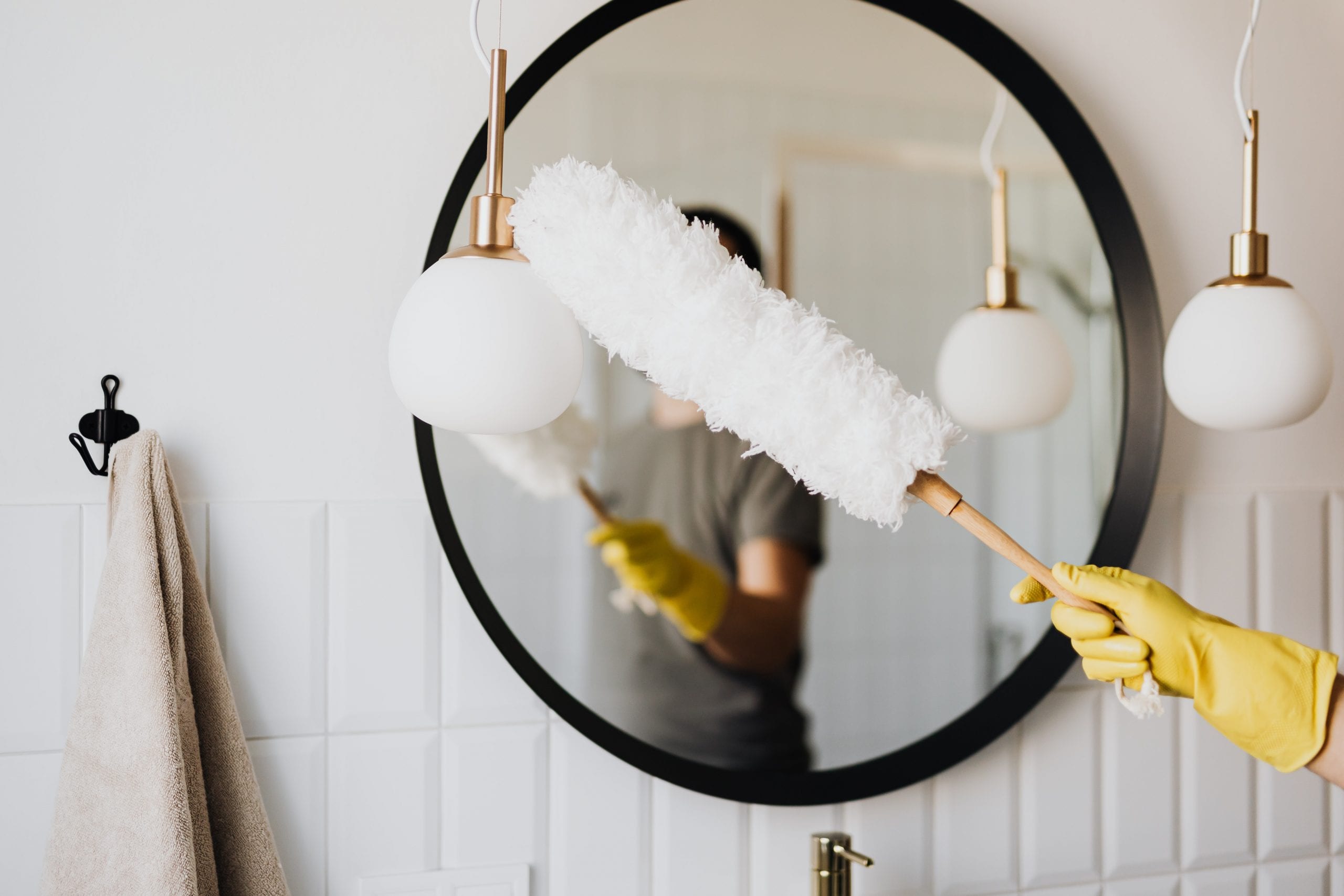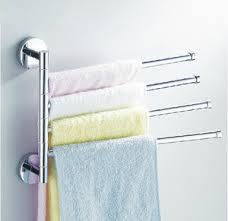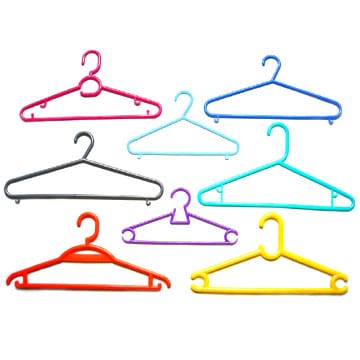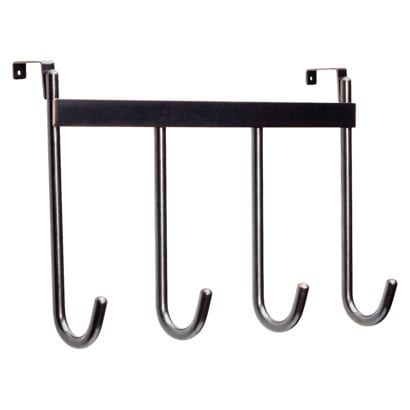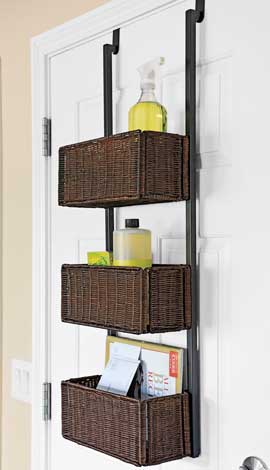Organizing Tips
Every year you set yourself resolutions, some you keep some you might not but if there is one resolution that should be attainable for everyone is the January de-clutter. In fact, there really is no better time to sort through, organize, and de-clutter than the post-Christmas holidays. You and your family have no doubt accumulated an awful lot of new stuff and you need to make room for it. Don’t let your new belongings sit on top of the old ones, use this time to donate the stuff you no longer use or need and make room for your appreciatively received new goodies.
How to start your New Year declutter
To successfully undertake a declutter you need to be organized with a plan and agenda, and you need to stick to it. Here are some ways to help you organize your decluttering.
- List your areas for decluttering; do not just wander aimlessly around your house opening random cupboard doors looking for inspiration. List where you want to declutter and start with the easiest area first or the area that bothers you the most.
- Have a deadline; decide on a time that you want each area decluttered by and give yourself sufficient time to do the work. It could be an hour, 10 minutes a day, or a full afternoon dedicated to one space. Whatever works for you.
- Develop a system; when it comes to going through all of your stuff put in place a system of what you are going to do with your items. A good place to start is by having four stations, donate/recycle, sell, trash, keep. Everything should go into one of these piles but your keep pile should be dramatically reduced. Remember if you haven’t used it in a year – donate it.
- Make sure everything has a place; if you are keeping it make sure it has a place to live and it stays there without causing mess or clutter. If it doesn’t have a place then make a place that is easily accessible and close to where you use it or don’t keep it.
Benefits of decluttering
If you still are not tempted to declutter, consider some of these benefits to help persuade you.
- Reduce stress and anxiety. Mess, clutter, and chaos in your home can have a negative impact on your stress and comfort levels. It can cause a sensory overload, you might feel embarrassed or stressed at the prospect of not knowing where things are.
- Easier to clean and tidy. With so much less stuff in the way, it will be easier to keep your home in order and keep things clean and tidy, which will inevitably make life easier when hosting and entertaining.
- Positive impact on selling your home. Having a clean, tidy, decluttered home will make selling your home easier. If listing your home is something you are considering doing a declutter is essential as all top realtors such as https://jenjewell.ca/ will conclude.
- Help to remove allergens. Dust, pet hair, and pollen can gather in all kinds of places and there is no better place than on tops of items sitting around taking up space and gathering dust. Getting rid of clutter should help to improve the airflow of your home and remove gathering dust and allergens.
If you need help with decluttering and organizing your home, purchase my online course, Create an organized home.
 Julie Stobbe is a Trained Professional Organizer and Lifestyle Organizing Coach who brings happiness to homes and organization to offices, in person and virtually. She has been working with clients since 2006 to provide customized organizing solutions to suit their individual needs and situation. She uses her love of physical activity to reduce clutter, in your home and office. She guides and supports you to manage your time. If you’re in a difficult transition Julie can coach you to break-free of emotional clutter constraining you from living life on your terms. Online courses are available to help instruct, coach and support your organizing projects. Get started by downloading Tips for Reorganizing 9 Rooms.
Julie Stobbe is a Trained Professional Organizer and Lifestyle Organizing Coach who brings happiness to homes and organization to offices, in person and virtually. She has been working with clients since 2006 to provide customized organizing solutions to suit their individual needs and situation. She uses her love of physical activity to reduce clutter, in your home and office. She guides and supports you to manage your time. If you’re in a difficult transition Julie can coach you to break-free of emotional clutter constraining you from living life on your terms. Online courses are available to help instruct, coach and support your organizing projects. Get started by downloading Tips for Reorganizing 9 Rooms.
Contact her at julie@mindoverclutter.ca
Click here to learn more about her online course Create an Organized Home.
Twitter – Facebook – Facebook group Organizing Mind and Space
Start wearing outfits for the last time this season
Which clothing should I keep?
Find a decluttering style
- category, one category at a time eg. look at all your pants, then shirts etc
- as they wear them – you put it on, don’t like it, donate it
- spending a little time every day and remove a few pieces of clothing
- having a box in their closet and when they find something they don’t like put it in the donation box
- spending an afternoon or evening and going through all their clothes at one time
- one room at a time – you may have clothes in a number of places
Consolidate: only clothing in your closet.
Organize based on your activities
Organize a colour palette.
Decide what percentage of clothing to declutter.
Capsule Wardrobe
What do I do with the things I don’t need?
Did I miss anything? Now I’d like to hear from you.
Need help?
Julie St obbe is a Trained Professional Organizer and Lifestyle Organizing Coach who brings happiness to homes and organization to offices, in person and virtually. She has been working with clients since 2006 to provide customized organizing solutions to suit their individual needs and situation. She uses her love of physical activity to reduce clutter, in your home and office. She guides and supports you to manage your time. If you’re in a difficult transition Julie can coach you to break-free of emotional clutter constraining you from living life on your terms. Online courses are available to help instruct, coach and support your organizing projects. Get started by downloading Tips for Reorganizing 9 Rooms.
obbe is a Trained Professional Organizer and Lifestyle Organizing Coach who brings happiness to homes and organization to offices, in person and virtually. She has been working with clients since 2006 to provide customized organizing solutions to suit their individual needs and situation. She uses her love of physical activity to reduce clutter, in your home and office. She guides and supports you to manage your time. If you’re in a difficult transition Julie can coach you to break-free of emotional clutter constraining you from living life on your terms. Online courses are available to help instruct, coach and support your organizing projects. Get started by downloading Tips for Reorganizing 9 Rooms.
Contact her at julie@mindoverclutter.ca
Click here to learn more about her online course Create an Organized Home.
Twitter – Facebook – Facebook group Organizing Mind and Space
Reading time – 5 minutes
With school out for summer and children around more of the time think about organizing things so they can keep their stuff put away. Too many times children can only do half of the job because the shelf is too high for them to reach and an adult needs to finish the job. Organize things so they can do the entire job of putting things away or getting things out. It will be less frustrating for everyone.
1. Place hooks so children can reach them and as children grow, the placement of their items should change with their higher reach.
2. Organizing items for children to use should be kept within their reach. If a child constantly needs help accessing these items this will cause frustration for both parent and child. Keep books, toys, dishes, coat hooks, clothes closet bars and towels at age/size-appropriate level.
3. Designate a place for sporting gear, helmets, pads, shoes etc. It may be a shelf or a pegboard with hooks or a mess bag. These 3 options allow the sporting gear to dry out before the next usage. It is important to air out damp items so they don’t get mouldy. When the children arrive home they won’t need to ask a parent what to do with their stuff and when an adult asks them to get ready they can easily collect everything they need. No more piles of gear left on the floor by the door.
4. Establish a routine for water bottles and lunch bags. Make sure the children know how to empty and recycle items from their lunch bag and where to put the bag for storing or use the next day. Do water bottles need to be washed every day or refilled? What is the rule in your household?
5. Wet swimwear needs to be hung up and dried or washed. Make a place for towels to be hung and bathing suits to be dried. Teach your children to wring out or roll their bathing suit in their towel before hanging it up. This will prevent a puddle of water from forming on the floor. Placing swimwear and towels on a hanger to dry may be easier to reach than putting it on a line. You may want to set up a portable clothes drier so it is easy for the children to reach.
6. Remember to always keep cleaning supplies and medicines out of the reach of children.
7. If children are permitted to use the microwave oven unsupervised, place the unit at a height where children can remove food easily without climbing on counters or standing on chairs. This will help prevent injuries from hot food spilling on the child or a child falling.
8. Label bins, drawers, and shelves with pictures or words to make tidying up quick and easy.
9. Establish a bulletin board, magnet board, or a wall covered with magnetic paint as an area to display children’s work. As new work comes home, remove items from the display area and put them in a box. When the school year is over, go through the box and decide which pieces to save and put away and which to recycle.
Did I miss anything? Let me know in the comments.
 Julie Stobbe is a Trained Professional Organizer and Lifestyle Organizing Coach who brings happiness to homes and organization to offices, in person and virtually. She has been working with clients since 2006 to provide customized organizing solutions to suit their individual needs and situation. She uses her love of physical activity to reduce clutter, in your home and office. She guides and supports you to manage your time. If you’re in a difficult transition Julie can coach you to break free of emotional clutter constraining you from living life on your terms. Online courses are available to help instruct, coach and support your organizing projects. Get started by downloading Tips for Reorganizing 9 Rooms.
Julie Stobbe is a Trained Professional Organizer and Lifestyle Organizing Coach who brings happiness to homes and organization to offices, in person and virtually. She has been working with clients since 2006 to provide customized organizing solutions to suit their individual needs and situation. She uses her love of physical activity to reduce clutter, in your home and office. She guides and supports you to manage your time. If you’re in a difficult transition Julie can coach you to break free of emotional clutter constraining you from living life on your terms. Online courses are available to help instruct, coach and support your organizing projects. Get started by downloading Tips for Reorganizing 9 Rooms.
Contact her at julie@mindoverclutter.ca
Click here to learn more about her online course Create an Organized Home.
Twitter – Facebook – Facebook group Organizing Mind and Space
Reading time – 3 minutes
My guest blogger this week is Making Your Small Space Feel Bigger from Downtown Apartment Company
Last week I reviewed a book that helps you to downsize the items in your home. Once your home is decluttered and organized a few design elements can make your room feel more spacious. It is important to organize your home so it suits your personality and lifestyle. As design is is not my strength, I invited a guest blogger, Downtown Apartment Company, to share a design graphic to help you with making your smaller space feel larger.
There aren’t many of us that live in a place that is as big as we’d like. We have to work with what we got. Luckily, there are ways to make your place feel bigger without adding any square footage. Coping with a smaller living space can be done with a few easy steps.
Using elements of design and psychology, you too can make your small place feel like a big space!
No matter the size, there are a lot of simple yet effective techniques and tricks you can do to really open up your place and make it feel roomier. An example is altering the colours, textures and patterns of your home. Changing the overall design is a fundamental way to affect how people will feel in it.
Using a monochromatic colour palette, for example, will make a room feel more airy and open, compared to a room with loads of contrast. Accenting your room with light fabric curtains and furniture with long, thin legs will also add to the impression that your place is bigger than it really is. Decorating your walls with striped elements will guide the eye horizontally or vertically to creating the feeling of additional height or width, as well.
Accepting your small space doesn’t have to mean feeling like you’re always trapped in a phone booth. Mastering the design elements below will help you and others feel less claustrophobic and more like the place you’ve always dreamed of.
Have I missed anything? In the comments let me know how you make a space feel larger.
Julie Stobbe is a Trained Professional Organizer and Lifestyle Organizing Coach who brings happiness to homes and organization to offices, virtually using Zoom. She has been working with clients since 2006 to provide customized organizing solutions to suit their individual needs and situation. She uses her love of teaching to reduce clutter, in your home, office, mind and time. She guides and supports you to be accountable for your time, to complete projects and reach your goals. If you’re in a difficult transition Julie can coach you to break-free of emotional clutter constraining you from living life on your terms. Online courses are available to help instruct, coach and support your organizing projects. Get started by downloading Tips for Reorganizing 9 Rooms.
Contact her at julie@mindoverclutter.ca
Click here to learn more about her online course Create an Organized Home.
Twitter – Facebook – Facebook group Organizing Mind and Space
Click here to learn more about working with a Professional Organizer.
This week my guest blogger is Sophia Perry from Arizona Moving Professionals
There comes a point when any household or a business needs additional storage space. Many people use it during a move or for decluttering and organizing purposes. While storage units are often a necessity when running a business, in recent times, they are becoming increasingly popular for people who recognize the importance of having a tidy living space. Hoarding items can lead to feeling snowed under and consequently anxious and frustrated. Hence, storage units are a practical solution. However, if you intend to use storage and free up some work or living space, be aware that, without a mindful approach, you’re risking turning your unit into the ‘land of lost and found’. Therefore, you need a good strategy for organizing your storage unit for frequent access to optimize the experience of your stressless, clutter-free lifestyle.
It starts with setting your priorities
Storage units are a multifaceted solution for storing a variety of items. Apart from helping with organizing a business inventory or a loved one’s belongings and heirlooms, people also use storage units to keep their cars and vehicles during the off-season, such as boats or motorcycles. If you’re moving, planning a home remodelling, or have a knack for interior design and decorating, a storage space is a guaranteed way to simplify your life. First and foremost, it’s important to consider the intent and purpose of the unit you’re using or planning to use. Click To Tweet
Create a mindful picture, and even better, an inventory list, of what type of items you plan to store. This will help you adopt a more organized approach towards your storage solution from the get-go. Otherwise, you’ll find yourself piling up unnecessary odds and ends and just spreading the enchanted hoarding circle outside your home or office. A storage unit is a fantastic way to declutter and harmonize your space or offset the stress of a move, as long as you prioritize keeping your items organized and easily accessible.
To organize your storage unit with success, create a master inventory list and set priorities regarding the importance of your items.
Plan the layout of the unit
The idea of vast space available to be used for storing your items might be tempting. However, you’ll need to consider what goes where to ensure you’re organizing your storage unit for untroubled access to your items. With this approach, you might realize that you have a lot of clutter to let go of and will surely provide you with a perspective on your priorities. All it takes is some pragmatic consideration of how quickly and how often you will need something.
Items that you use less frequently, or hardly ever, should go at the back of the storage. For a smooth transition, let movers load these last in the truck, as they will be unloaded first and consequently dropped off at the back of the storage unit. This is a good chance to give these items a second thought. Try to determine why you are keeping them and what do you need them for. Not only will this help you to arrange your unit for efficient access, but it will also give you a clear picture of the scope of your possessions.
Have a practical idea about the layout of your storage unit to ensure quick and easy access to your items.
Decluttering a storage unit
If you’ve been using a storage unit for a while, you know how fast and easy it fills up. However, with an effective decluttering and organizing method, you can have it sorted for smooth access to your storage unit. Without a doubt, decluttering is the toughest task, but it’s also rewarding in so many ways. A functionally organized, clutter-free storage area will enable you to find anything you need with ease, and you’ll save time and enjoy peace of mind. You can ask friends to lend you a helping hand or hire a professional junk removal company. Depending on the size of your storage unit inventory, you should plan accordingly on how much time you will need to get the job done. You can book a full day in your calendar to dedicate to decluttering your unit. Challenge yourself, commit and stay on task. The reward is a feeling of ease and relief once you see it through, and ultimately, effortless access to your needed items.
Decluttering a depot is a daunting task, so asking friends or hiring professional services can be of great help.
Find creative ways to sort out items
Although decluttering can be a challenging task, with a good plan and a mindful approach, everything is achievable. Give yourself a little pep talk on the importance of organizing your space for some healthy motivation. Since the purpose of a storage unit is to keep your items, their safety and easy access to them can impact your mood. Hoarding or not even knowing what things you possess can lead you to feel overburdened. Use your master inventory list to determine what is relevant for keeping and what’s worth parting from. Divide your excess items into groups, and decide what to toss, donate or sell. For a smooth and efficient decluttering project, take out the items you intend to dispose of first. Subsequently, it’ll be much easier to deal with things you plan to sell or donate. With that being done, you’re one step away from fruitfully organizing your storage unit for frequent access.
Divide your items into categories to efficiently declutter and organize your storage unit.
A neatly organized storage unit
If you run a business, frequent access to your storage unit is a given. As a matter of fact, even if you use it to store items other than office inventory, an organized storage space will help you feel more in control of your life. Once you’ve carried out the decluttering project, you may have noticed how relaxed you feel. With no junk to obstruct your way, you’ll be able to organize your storage unit neatly and have everything you need on hand, without having to waste precious time and energy searching through the mounds. In your recently created clean storage space, stack and group your boxes from the least needed at the back to the ones you need more frequently accessed toward the unit’s front entrance. Allow some space in between rows of boxes to create aisles for easy navigation. Last but not least, label the boxes according to their contents, and make sure the tags are facing outward and are easy to read. This is the most efficient method for organizing your storage unit for frequent access, which will make the chaotic mess and clutter, and the anxiety that comes along with it, a thing of the past.
Share your tips for keeping a storage unit organized.



Contact her at julie@mindoverclutter.ca
Twitter – Facebook – Facebook group Organizing Mind and Space
Click here to learn more about working with a Professional Organizer.
Yard sales are an excellent way to meet people, make some money and have fun. There are many ways to organize a yard sale. Timing of the sale is important to the success of the sale. You need to be flexible about pricing if you want to have less stuff at the end of the day. Let’s start with the easiest way to prepare for a yard sale.
This way takes less time and energy to set up.
Get a number of boxes or bins to collect your items. Mark each container with a price $1.00 $2:00 $0.25 $0.50 $5.00 etc. As you are collecting your items for the sale decide how much you will sell the item for and put the objects of the same price into the same box. You are pricing items as you sort them so there is less work to do later. Using boxes means you don’t need to price every item individually with a sticker. Many charities will not take items leftover from a yard sale. Part of the reason is they would need to remove all of the stickers.
Have separate display areas /tables for each price grouping. Place a sign on the front of each of the tables explaining everything on this table costs _______. You are finished and ready to have a great day.
This way will help you to have less stuff at the end of the day
Group your items into batches. For example a set of dishes, all the hand tools, groups of 10 books, baby clothing of the same size, CDs DVDs. The person needs to buy the entire batch not just part of it. This way helps you to move more items on each purchase. They buy 10 CDs for $5.00 instead of 1 for $0.50. Place batches of items in boxes or see-through bags.
This way makes sure you get the correct price for the item
If you want to use tags the easiest way is to:
- use one tag colour per price group.
- red for $10.00, blue for $5.00 etc.
- place a colour-coded sticker on each item and when the person buys it, you know exactly what to charge.
- Make a sign explaining that each colour represents a specific price
If you want to do more work you can price items individually.
- Place a sticker on the item and write on it the cost of the item.
- This is good for large items that you will be priced higher.
In special circumstances, tags are very helpful if:
- the garage sale is for multiple families you can assign each group their own colour and you know which cash box to put the money in.
- multiple family members are selling items at the same sale you can assign each person their own colour and you know which cash box to put the money in.
You will need to remove the stickers after the sale before you can donate items.
How much should it sell for?
Pricing
If your goal is to sell stuff so you have less at the end of day price items:
- 50% of the original price for brand new or barely used items
- 25% – 30% of the original price for the older items
- You can always ask them to make you an offer. You might get more than you expected or less.
If you have more expensive items to sell do your research to determine a fair price for the article.
Sometimes a yard sale seems like a great way to make money. Make sure you are the type of person who likes to barter and is not offended when people tell you that something is not worth the value you have placed on it.
If you will be offended and not make a sale, a yard sale is not for you.
To ensure you get the sale by having change.
Make sure to never leave the money unattended. Keep the money in a waist pouch so it can’t be stolen.
Change
- have $25 in change
- $20 in $1, $4 in quarters, $1 in dimes and nickels
- If you don’t have change people will not buy from you.
Timeline for preparing for a yard sale
It takes time to set up and clean up from a yard sale.
- sort, clean, price 1 – 2 days
- advertising 2 hrs
- arrange and display wares 4 hrs
- get change 1 hr
- tag sale itself 1 or 2 days
- take unsold items to charity 3 hrs
Advertising
Advertising is a big part of the success of the sale. There are lots of Facebook sites, Kijiji and Craigslist where you can advertise for free. You may also have a local paper where you can place an ad. Put up signs to let people know where the yard sale is located especially if you are not on welled travelled streets with lots of cars and foot traffic.
Pick your date wisely. Spring and fall are the best times of the year. Long weekends are times when people travel. Weekends are usually better than weekdays. If you can do it with a number of families from your street at the same time you will get better results.
Is a Yard Sale for You?
Yard sales can be a fun way to get rid of your clutter, make some money and meet people if the weather is good. If you feel you don’t have the time, energy, a good location, great items for sale or don’t like bartering you may want to donate your items to a charity and spend the day doing something else.
How will you organize your yard sale? Maybe I didn’t mention your favourite way. Either way, leave me a comment.




Contact her at julie@mindoverclutter.ca
Click here to learn more about her online course Create an Organized Home.
Twitter – Facebook – Facebook group Organizing Mind and Space
Click here to learn more about working with a Professional Organizer.
Just because something brought you joy in the past doesn’t mean you should carry it forever. The possessions you keep should represent the person you are trying to become, not the person you were. Keep this in mind when you start your decluttering journey. As you start to let go of things it will become easier and easier. Here are steps to help you on your path to finding your treasures.
Planning the space
1. Decide what the goal is for the room. Is it to have a:
- Beautiful compact space
- Functional workshop
- Sense of freedom and control
- the Joy of financially exchanging stuff for new experiences and pleasures.
- Clear out a parent’s home
- Make things easier for the next generation
- Streamline your lifestyle
2. Decide what you want the room to look like and be used for. Draw a floor plan and make a list of activities that happen in that space. It will help you to know what to keep.
3. Decision criteria
Set up some questions to help you with your decision making. Here are some examples:
- How many of these do I have? How many is enough?
- Does the item fit in with my values?
- Is this item current?
- Is this item really valuable?
- Will owning this help to resolve my clutter?
- What is the worst thing that can happen if I don’t have it?
- Can I borrow it from somewhere?
- Does it bring me joy?
- Do you need it?
4. How much is enough?
Look around the room and decide what percentage of stuff you need to give away so everything will fit into the room. 25% 50% 75%?
5. If you don’t schedule it, it won’t get done.
Schedule time do it when you are not rushed. Do one area, room, box or even corner of a room depending on how much stuff you have to go through and your deadline.
6. Prepare the room for working.
You will need a series of boxes, bins , bags or containers. for garbage, recycling, donations, items to go to other rooms, items to return to people.
5 Methods for decluttering the room
I’m going to go through a number of ways to sort through your items and you can decide what method works best for you. At first, decluttering is easy because you find items that you know you don’t want and just haven’t given them away yet. Then it becomes more challenging. You must chip away at identifying which items are true treasures versus those you feel guilty about giving away. Remember to reduce by the percentage you choose in your planning.
1. Have a box
The simplest way to start is to keep a box in your closet and whenever you find something you don’t need put it into the box and you can start decluttering right away.
2.Skimming
- Go to a closet/cupboard and select the best items in each that category.
- Most cupboards/closets will have more than one category.
- For example, in a kitchen, the cupboard might have baking dishes, casserole dishes, muffins tins, loaf pans. Pick the best 1 or 2 of each of these 4 categories and donate the rest.
- Continue to open each cupboard and drawer skimming the contents and selecting 1 or 2 items from each category.
3. Sort then declutter
- Go clockwise around the room sorting items into groups by function
- Do the surfaces first and then the drawers and cupboards next
- When you are done, the garbage and recycling will be collected and removed from the room
- All the items in the room will be in groups
- Each room will have different categories/groups of items. Here are some examples, books, electronics, tools, dishes, home decor, games, clothing, photos etc
Look at one category/group and apply the questions and percentage you determined in the planning stage. Start removing items.
If that method doesn’t work for you and you are keeping everything, try a different method.
4.Grouping
Keep the Best of the Best. Instead of thinking about giving things away, it might be easier to think about keeping the best.
- After you have sorted the room make sure you are keeping the best one. You need to see all of the items in one group together and keep only as many as you need or the percentage you set in the planning stage, keep the best ones.
5.Triage
- Gather all your items from one category
- Pick up the first three and remove the one you like the least.
- Pick up 3 more and remove one again
- After you have gone through the category/group you will have decluttered by 1/3
If you are sentimental
- Try taking a picture of the items so you have the memory and let go of the item go.
- Find a good home for the thing you are letting go of, they are still useful just not to you anymore.
- “Shrink it”, only keep one item from a collection instead of the entire collection, you will still have the memory
- Ask yourself, what would be best, having a number of boxes with large quantities of unsorted keepsakes or a carefully assembled box of very precious treasures?
Decluttering is about having a mindset of letting go and having less. Once you experience the joy of being unburdened from cleaning, organizing, buying, repairing stuff you don’t need, want, use or like you’ll wonder why you didn’t start sooner. Enjoy the journey. Set your goals, develop your decision criteria and then begin decluttering your space. Click To Tweet
Did I miss anything?
If you need help to start your decluttering project work with me virtually on zoom.
Julie Stobbe is a Trained Professional Organizer and Lifestyle Organizing Coach who brings happiness to homes and organization to offices, virtually using Zoom. She has been working with clients since 2006 to provide customized organizing solutions to suit their individual needs and situation. She uses her love of teaching to reduce clutter, in your home, office, mind and time. She guides and supports you to be accountable for your time, to complete projects and reach your goals. If you’re in a difficult transition Julie can coach you to break-free of emotional clutter constraining you from living life on your terms. Online courses are available to help instruct, coach and support your organizing projects. Get started by downloading Tips for Reorganizing 9 Rooms.
Contact her at julie@mindoverclutter.ca
Click here to learn more about her online course Create an Organized Home.
Twitter – Facebook – Facebook group Organizing Mind and Space
Welcome to the new year. I hope you have challenges you conquer, joys you share and fun to revitalize yourself.
I am a naturally organized person. It comes very easily to me. Many people find getting and staying organized difficult. You will enjoy reading my guest blogger’s article on how to become neat by Sophia Perry of Arizona Moving Professionals.
Trust me when I tell you that a messy person can learn to be neat. As a former slob who daily transferred a ginormous pile of semi-dirty clothes from bed (when it’s sleep time) to the work desk, and vice versa, I can tell you, you too can transform. I don’t even know how it used to get to the point of having almost the entire content of my wardrobe on the bed. But it did.
And the story doesn’t end there. The most frustrating thing was the laundry. I wash one round. While it dries, the second is being washed. I still haven’t folded the first one, and the second is drying. Soon there is the third round. And the rest of my wardrobe is now clean but wrinkled beyond recognition, on an armchair waiting for something to happen. And when I finally get around to dealing with those mountains of clothes, I end up with a closet so messy that I don’t even know what clothes I have. I wish I could say these were my greatest issues, but… There were also dishes. Technically, the situation was the same as with the laundry. It’s just that I never managed to empty the dishwasher, so new dirty dishes piled up in the sink, and… Well, you get the picture. However, there is help! Much like the 12-step program, here too, there are steps to take to get on the path of tidiness.
1. Designate a place for each and every item you possess.
After a long day at work, believe me, I understand the tiredness. But don’t drop your pants, key, and shoes wherever you see fit and leave them lying there until you need them again. If you know that shoes belong in the hallway, keys on a peg next to the door, and jeans in the closet, go put them there. Repeat every day. It will start feeling normal. It will become an automatic thing.
2. Eyes on the prize – visualize the outcome and work on the road to get there.
To stay motivated, it’s vital to be realistic. Start small. Set a few attainable goals every day, and cross them off the list once you’ve done them. The crossing off will create a feeling of accomplishment and get you incentivized to keep going. It’s like training yourself. In addition to daily plans, start making weekly and monthly plans as well. Put them up on your fridge, so you remind yourself of what needs doing. It will bring some organization to your life.
Motivation can come unexpectedly. For example, once I heard a motivational speaker, whose name I can’t recollect, say: “If your bed is a mess, your life is a mess.” He explained that it’s his morning routine that makes him successful. He gets up, works out, and makes his bed. Making the bed is a task he completed early in the morning. So he set himself up for success. He already accomplished something. Needless to say, I have made a habit of making my bed every morning now.
Set small goals every day and cross them off the list. It will make you feel like you have accomplished something.
3. Stop with the hoarding.
Stop piling up clutter. Having too many things is what complicates the cleaning process. And not just that, too many items to wipe, move, and dust are downright overwhelming. As Marie Kondo says, and I’m paraphrasing – if it doesn’t make you happy, get rid of it. Also, if you haven’t used it for a long time – get rid of it. If you don’t need it – you’ve guessed it, it goes out. Finally, don’t accumulate sentimental knickknacks. Don’t get attached to things. They are just things. Many have fallen into this trap. If you don’t enjoy, need, or use something, lose it. A messy person can learn to be neat if they learn to declutter mercilessly! I have come to despise ornaments with no purpose, just because they add to the cleaning time. And time is precious.
Moreover, clutter can get in the way of productivity. Therefore, tidying up your workspace is very important. This is especially crucial if you work from home. There are already too many distractors. And several dirty coffee mugs, a mountain of clothes on your chair, and dirty socks on the floor are not helpful. Also, too many things on your desk, such as purposeless ornaments, don’t make for a suitable working environment.
Clutter can get in the way of productivity. Keep your workspace tidy and organized.
4. Simplify cleaning.
How can cleaning be simplified, you wonder? Well, simple. Organize your home so that it’s easier to tidy. Decluttering is one way to do it. But you can do more. For instance, I’ve realized that curtains really make my life difficult. So I got rid of them and replaced them with zebra blinds. They are stylish, modern, and, most importantly, easy to maintain. There is no washing, ironing, or hanging. Just an occasional wipe with a wet cloth and a bit of dusting. Good quality ones are antistatic, so even dusting is optional. Think of the areas in your home that cause you the most headaches, and figure out ways to make them more manageable.
5. It all boils down to making new habits.
Make yourself do something, even the smallest thing, every day. Not every week or every few days, but every single day. The point is to make it a habit to keep your home neat and tidy. If tidiness doesn’t come instinctively, you must train yourself. Basically, repeat until it’s a routine. Every time you leave a room, try to leave it better than you found it. Put a thing or two away. As you cook, put dirty dishes in the dishwasher as soon as you are done with them. Wipe the surface the second you spill something. Don’t let things get really filthy. So big cleaning will be less frequent.
If tidying up doesn’t come instinctively to you, make a habit of it.
A messy person can learn to be neat
Some people call it a creative mess. Some say they can only function in chaos. They claim they can’t find anything if their home is tidy. But is it really true? Or are those excuses? Old habits are hard to break, but a messy person can learn to be neat. It’s essential to change self-image. You are not a slob or a lazy person – you need to purge. Rid yourself of clutter and bad habits. Finally, make positive associations with cleaning. Listen to music or an audiobook. That way, an unpleasant, mundane task will become something more enjoyable.
Let me help you to leave your messy self behind. Book a 30-minute complimentary virtual organizing assessment. https://mindoverclutter.as.me/virtualorganizingassessment




Contact her at julie@mindoverclutter.ca
Twitter – Facebook – Facebook group Organizing Mind and Space
Click here to learn more about working with a Professional Organizer?
The bathroom has a lot of use by a number of people. it is a high traffic area in the home. Use the space well in the bathroom to make storage efficient. Here are 5 tips to help make your bathroom function better and safely.
1. Have a drawer for each person who uses the bathroom to store his or her toiletries and cosmetics. If you don’t have the space to store items in the bathroom, give each person a basket to transport their things to the bathroom from his or her bedroom, where the basket is stored.
2. Purchase under-sink storage shelves or baskets to make good use of this under-utilized area.
3. If medications are stored in the bathroom, safely store them where small children can’t gain access.
4. Store cleaning supplies safely, out of the reach of children, nearby so you can do quick cleans ups.
5. Add hooks or towel bars to the walls or over-the-door racks/hooks to hang and dry towels after use. Not enough room in the bathroom? Install hooks or bars in the bedrooms. This will keep towels off the floor, neat and clean.
Here is a link to a lovely informatic from Modern Bathroom to help you have a visual of organizing a bathroom.
If you need help organizing your bathroom book a 30 minute complimentary virtual assessment.




Contact her at julie@mindoverclutter.ca
Twitter – Facebook – Facebook group Organizing Mind and Space
Click here to learn more about working with a Professional Organizer?
Bring lots of hangers, you can never have enough. It is a great way to make new friends by sharing the extra hangers.
1. Store your clothes in the closet. Double your hanging space by purchasing a lower hanging bar. Add an extra shelf up high in the closet to store off-season items mitts, hats.
2. Under-bed storage containers are very helpful for sports equipment, food, laundry detergent, musical instruments, etc
3. Use vertical space to add more storage. There are many types of carts with drawers which can be used to store school supplies, cosmetics, food etc.
4. Use the inside of the bedroom and closet doors to hang items. Over-the-door rack and hook products accommodate coats, clothes, etc
5. There are many pocket style items that hang from the closet bar. Buy one or a shelf for shoes to use to double the shoe space storage.
6. Make sure anything you buy is returnable because you won’t exactly what you need until you get there.
Need some help planning your move book a 30 minute complimentary appointment to get help planning the space in your new room.


Contact her at julie@mindoverclutter.ca
Twitter – Facebook – Facebook group Organizing Mind and Space
Click here to learn more about working with a Professional Organizer?
